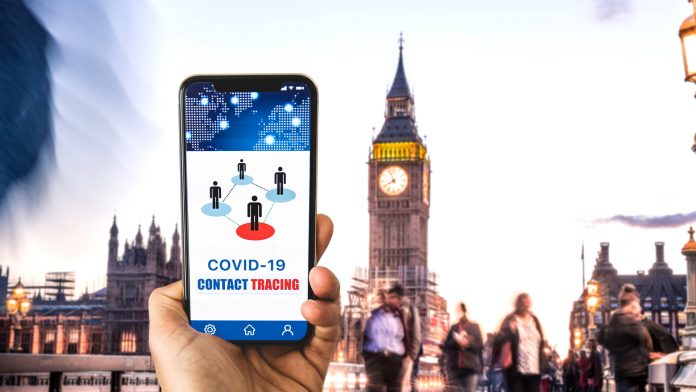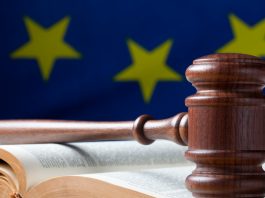Willem Jonker, CEO of EIT Digital, spoke to Innovation News Network’s Georgina Ryan about digital transformation during the pandemic, Europe’s struggle with COVID-19 contact tracing apps and adopting physical tokens as a simple and secure alternative to current tracing methods.
Since the spring of 2020, European authorities have implemented COVID-19 contact tracing apps using smartphone technology, in efforts to help control the virus. EIT Digital argues that so far, contact tracing apps have not been very successful.
Despite COVID-19 vaccination programmes starting, lifting lockdown measures will be a gradual process, and close monitoring will be essential to avoid local outbreaks turning into larger-scale lockdowns.
Therefore, tracing and tracking will remain essential for the foreseeable future. In order to avoid the existing problems with contact tracing apps, alternatives to current systems must be investigated. EIT Digital is calling for governments and private companies to consider tracing token technology as a viable alternative.
How has the COVID-19 pandemic accelerated digital transformation?
The main shift has been that a lot of interaction, at least for people that used to work in offices, now takes place from home, supported by communication platforms, and a variety of companies have benefited from this.
The issue of the environment has become more prominent because there is a link between working from home and the reduced travel that comes with that, and a reduction in carbon footprint. The pandemic has shown that things can be done differently, by using digital technology to host meetings and conferences, amongst other things. The pandemic is lasting longer than most expected and the longer these things take the more profound impact they have on how people change their way of work. Therefore, I think there will be a lasting effect on how people work and live.
Throughout the pandemic, there has been an increasing emphasis on the connection between digital and the environment, which I do not think was as visible before. Of course, people working in the field and people using technology had been advocating it, especially remote working, and telemedicine, but now it is much more than that.
Going forward, I expect to see a boost of activity when it comes to development on the intersection of digital and climate. We can already see concrete examples; technology has benefited quite a bit from the pandemic. You see it on the stock markets, but also very notably, companies like Tesla have enormously benefited and they are very advanced not only in having electric cars with very advanced car management systems and so on, but also when it comes to autonomous driving, which is all about digital.
Finally, there has been the use of digital in supporting the fight against the pandemic. And I think that is a bit of a mixed picture. So, of course, digital technology helps in supporting logistics, and making things faster, as well as, in vaccine development, and virus mutation prediction by running computer models in high performance computing environments, as well as mutations variations and predictions.
There was a lot of expectation that digital would have a strong role in in fighting pandemic outbreaks, especially through contact tracing. The applications of this have shown the limitations of digital. It is also shown that simplicity and privacy concerns are extremely important, and we cannot expect that just because everyone has a mobile phone, that they will all download a contact tracing app.
In terms of Europe getting a strong position in digital, if you look to contact tracing apps, this has not really happened., The usual fragmentation was there, and every country went for its own solutions that were not interoperable. Ultimately, big tech was the big winner, because Apple and Google quickly agreed on a common way of tracing and building it into their operating systems.
I think this whole pandemic really brings a lot of different lessons with it. The key ones in digital technology are, of course, communication technology, exchanging and analysing data, to help find better treatments, and the connection between digital and the environment. The direct contact tracing, on the other hand, has been less of a success.
From the perspective of EIT digital, what are the key trends going forward? Do you think the priorities for Europe will have changed? And can you highlight any start-ups you think will play an important role?
As mentioned before, a key trend going forward will be digital and the environment. The characteristics to look for are digital solutions that replace current ways of working and have a clear advantage when it comes to the environmental footprint. For example, a video meeting has a lower carbon footprint than a physical meeting.
The other area to consider is that the digital sector is a massive energy consumer. The enormous growth of data centres is consuming a significant part of the green energy that is produced. Currently, there are serious debates about it: we start to increase green energy production, data centres want to be green, they buy all this green energy and there is not enough produced to meet the demand for energy. Therefore, green and energy efficient data communication and data processing and data sensors, as well as technologies that can contribute there will also be important trend.
Another trend is information provisioning, through social media channels, and there is currently a struggle with this. There is the issue of freedom of speech. Another issue is that you cannot always verify what is true, you see that with video technology and with artificial intelligence, it is easy to fake videos, photos, and statements. Therefore, the whole technology of authentication, which is part of cyber security, is about being able to verify that content is authentic and factual and being able to find a good balance between freedom of expression and avoiding misuse of communication channels for spreading false information. As we can see, there is a need for more and more technology that supports in managing those information streams, because you can see its impact. You can also see the impact that these big tech platforms have. A recent example is Twitter’s decision to close the account of Donald Trump, where we were in the situation where a single company was able to cut off even the president of the largest, most powerful nation in the world. Regardless of views on this case specifically, we can see that this could be used for good and for bad reasons.
I think going forward we will see policy, regulation, and technology coming together to make that manageable, because this decade has been the decade of social media platforms and we are only just starting to understand how they work. In the next decade, we will find a better way of handling these situations without leaving those decisions to individual companies. Of course, this is amplified now because the pandemic has also given rise to a lot of conspiracy theories and fake news is being much more aggressively pushed over these social media platforms. The pandemic is an extreme situation, but it is in these extreme situations, where we can learn a lot about where the real challenges of certain technologies are.
You wrote an article in April 2020, about the European struggle with COVID-19 contact tracing apps, where you said that the “fragmented approach of individual European countries” is “doomed to fail”. To what extent do you think Europe is still struggling with contact tracing apps? And has a more coordinated approach been taken since the beginning of the pandemic?
I am afraid that my prediction has so far been proved accurate. You see many diverse implementations, and a far too low uptake. In many countries you see downloads of tracing apps at 10-20% maybe 25% for the better ones. And that is just downloads; it is not clear how many people are using this software. So yes, Europe is still struggling in regard to contact tracing systems.
The reasons these systems have not been a success are because privacy and simplicity were not the main priorities. In the end, the key driver was a technology push. It was a matter of: this is the technology we have already – mobile phones with Bluetooth – let us see what we can do with the existing technology, rather than looking at it as: this is what we need, this is how it needs to be integrated in the overall system of testing, tracing, quarantine measures, partial lockdown, targeted lockdowns etc, it is a whole collection of measures where contact tracing needs to be an integral part.
We have generated our own initiatives in parallel, specifically physical tokens that are much simpler. As well, they are, by definition, anonymous and if you design the system in the right way, there is no other data. The question is whether governments are really going to pick it up, are they going to invest into a new solution? However, we also do not always need to depend on governments. For example, if you want to reopen a school, children could be given a token to monitor outbreaks. Right now, if there is an outbreak, people are so cautious, and entire schools end up closing. But if there are 1,000, pupils at that school, and it breaks out with two or three infections, that have only been in contact with 100 pupils, you can be much more selective. This can be done just through giving students a token to carry around.
So, the use case scenarios are very clear, we have made sure that we supported initiatives that have taken that up. And that has resulted in five companies across Europe that are producing these tokens at the price level that we indicated. We are now working with them in the reopening and recovery period, to use this technology, for those specific use case scenarios. In Singapore, tokens have successfully been deployed next to the app and that is where our focus will be: to use them in the recovery. This method can also be deployed by private companies. For example, a business with 500 employees should not be forced to close if a single employee has the virus, and the employer knows, because of the tokens, that the person has only been in contact with 20 people. The next step is to quickly test those people, but of course, the right infrastructure must be in place.
I think what also happened, especially in Europe, is that most countries did not have their testing infrastructure in place and were hesitant that if the apps generated a lot of false alarms that would put pressure on the testing facilities.
What can we learn from the application of the centralised and decentralised models of tracing apps?
If you look at Europe, in the end, everybody turned to a decentralised model. So, what we have learned is that the population does not trust the government enough to hand out such close surveillance data, and, therefore, the decentralised model had to be opted for. Some governments understood this early on, and some learned the hard way and had to make a U-turn, like Germany, and later France, to steer away from a centralised model. We also saw, in centralised approaches, the mix between the contact tracing functionality, which is very limited, and the wish for broader monitoring of the development of the pandemic, to correlate data and run statistics on, what groups within the population had been affected. But that is, of course, much more than the simple contact tracing. If you bring additional functionality of data analytics, you must decouple that because that information you can get from other places, you can get from tests, from hospital, registrations, and so on. You can also get that from the anonymous overall aggregated information that you will get from the app, and that does not need to be centrally stored and collected. So, in practice, decentralised was the way to go.
Is the European Commission’s interoperability gateway system operating effectively? Is having national apps linked to the system, mitigating the fragmented approach discussed earlier? And have there been any issues with personal data and information exchange because of the system?
We know that 11 or 12 Member States have coupled their app to the interoperability service, but we have no information about actual use of the interoperability server, how much data is available, how much is used, how effective it is etc. The other element that I am not 100% sure of is that you have two things that you must harmonise. One is the technical interface – you must make sure that the data is there, the alerts are forwarded between the different systems and so on. However, in certain countries, such as the Netherlands, the apps operate under a specific temporary law that was installed to support the deployment of the app, and I am not sure that technically connecting it to other apps and bringing in contact tracing data is allowed within that legal framework. My first intuition is that might not be the case, because if my data is used in the context of a French, or German, or Italian or Nordic app, it may be that those apps have no specific regulations around them, so how is my government going to guarantee that my data in that app is treated according to the legal framework that they created with Dutch legislation? I am not deeply into the technicalities of all the specific laws that have been put in place to treat the pandemic at a national level, but intuition would say, if countries develop their own apps, they are not compatible. We can do something with interoperability at a technical level, but if countries develop their own legislation, it is unlikely that they are fully interoperable.
Does Europe have sovereignty over its tracing apps and how important is the issue of digital sovereignty?
For most countries, the app is developed by national organisations. So, at the government’s request, IT companies, or software houses built an app. So, the pure app itself has been built, and is also owned by the governments. However, these apps sit on interfaces that give the actual tracking and contact information, and that comes from the Apple-Google solution. So, that means that the essential part is not under their control, because that is embedded in the operating system, and the app is a layer on top of it. Apple and Google indicated in the early days of the pandemic that they would authorise, per country, one app to have access to that data, and that would be the official government-authorised app. And every country would get access for only for that app. So, there was a protocol that if you just built the app, you could not access it, you needed specific keys to open it up and the keys to access the platform are literally in the hands of Apple and Google, and the data itself, is encrypted.
Finally, in the event of another pandemic, or a similar crisis, what lessons must be carried forward? And what could be done differently?
It has become apparent that most European countries were not well prepared for a pandemic: we did not have the infrastructure, we did not have the protocols, we did not know how to quickly build up and to fight. We have learnt a lot, and this must all be acted upon, because medical experts tell us that it is likely that viruses could turn into a pandemic more often. And, of course, the challenge is to avoid it becoming a pandemic, and that requires two things.
First, it requires enormous co-ordination: The World Health Organization should have a much more prominent role in early monitoring, collecting information and so on. But also, when it pops up somewhere countries should be equipped with protocols of what to do. In the case of this pandemic, it was invented as we went along. Therefore, I expect that there will be expertise centres set up. And, I believe we must make sure these are multi-disciplinary centres. My concern is that because a pandemic is a healthcare issue, fighting it is only seen as a healthcare issue, but it is much more: It has to do with logistics, planning, and mental health.
Of course, you need to know how viruses work, how you can treat them, and so on. But you also must know how to act in a society against it, how to deploy fast testing, how to make sure that you can have a much less severe impact on the economy, and that the wellness, and mental wellbeing of people is considered. The question is, will that happen? Because, when it is behind us, then the first focus is on relief. Let us get back to normal, whatever that may be.
If you look specifically to digital, I think it would be wise to look at different levels: from supporting remote work and data analysis, all the way to tracking and tracing apps that are very specific for a very specific case. There is also the issue of technology firms suddenly getting on control points. What are the consequences of that? And so on. We can learn a lot from this, especially in this discussion of digital sovereignty.
As it goes with history, an important event gives historians a long time for a lot of analysis. You can still get the new books today with yet another perspective on World War II. But this time, it should not only be our medical friends, it should not only be historians, but it should also be engineers and digital experts, who reflect on and analyse what has gone on and draw conclusions towards the future. If I had to say one thing that I think governments should do, it would be to build a permanent pandemic response unit, and make sure it is multidisciplinary.

Professor Willem Jonker
CEO EIT Digital
https://www.eitdigital.eu/
Contact: Vanessa Perez – vanessa.perez@eitdigital.eu









